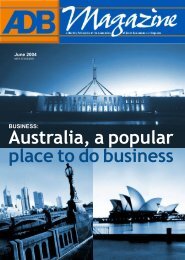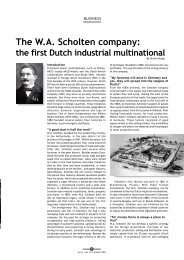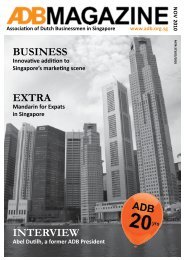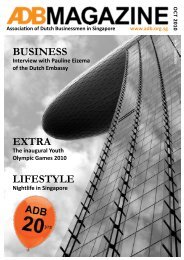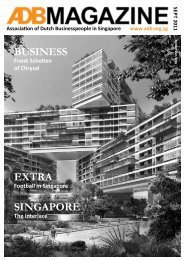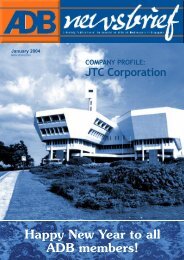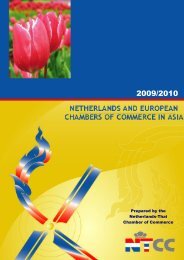June - July 2013 - Association of Dutch Businessmen
June - July 2013 - Association of Dutch Businessmen
June - July 2013 - Association of Dutch Businessmen
Create successful ePaper yourself
Turn your PDF publications into a flip-book with our unique Google optimized e-Paper software.
Events<br />
Singapore Chinese Orchestra<br />
A peep behind the scenes<br />
Text Aleid van der Schrier<br />
Photos Lineke van Nederpelt<br />
On April 15, around 50 ADB members paid a visit to the<br />
Singapore Chinese Orchestra at the Singapore Conference<br />
Hall, located in the Central Business District. It turned out<br />
to be an enchanting evening, filled with an interesting<br />
blend <strong>of</strong> Asian and Western music. And one thing is for<br />
sure, it made us curious for more!<br />
The host <strong>of</strong> the evening was Ferry de Bakker,<br />
who volunteers as a consultant for SCO. The SCO was<br />
inaugurated in 1997 and is Singapore’s only pr<strong>of</strong>essional<br />
Chinese orchestra. It aspires to be a world renowned<br />
Chinese Orchestra with a uniquely Singaporean<br />
character. To achieve this, SCO is working on getting more<br />
international recognition. One way to do that is to invite<br />
different types <strong>of</strong> business groups to networking sessions,<br />
where SCO can present itself.<br />
Chinese classical music and instruments<br />
The evening started with a presentation <strong>of</strong> Chinese classical<br />
music and instruments by Mr Quek Ling Kiong, resident<br />
conductor. In a Chinese orchestra, there are four groups <strong>of</strong><br />
instruments: wind instruments, plucked string instruments,<br />
bowed string instruments and percussion instruments. The<br />
wind instruments contain amongst others the ‘bangdi’,<br />
which is a kind <strong>of</strong> bamboo flute, the ‘suona’, also called<br />
a Chinese trumpet and a ‘sheng’, which is an ancient<br />
Chinese instrument, made <strong>of</strong> several small pipes, similar<br />
to an organ. The plucked string instruments are unique to<br />
a Chinese orchestra and are played by using the fingers.<br />
The ‘yangqin’ is a kind <strong>of</strong> laying harp, while the ‘quzheng’,<br />
which has 21 strings, is the Chinese harp. This section<br />
also consists <strong>of</strong> different string instruments <strong>of</strong> different<br />
sizes, including the ‘pipa’, the ‘ruan’ and the ‘sanxian’. The<br />
largest section in a Chinese orchestra is the bowed string<br />
instrument section, which makes up 50% <strong>of</strong> the orchestra.<br />
In this section there are two Western instruments, the<br />
cello and the double bass. The Chinese instruments are the<br />
gaohu, the erhu and the zhonghu, which all look the same,<br />
but have a different tonal range. The last section consists <strong>of</strong><br />
the percussion instruments.<br />
During the presentation, ‘You Tube’ videos <strong>of</strong> SCO<br />
performances were shown to illustrate the abovementioned<br />
instruments. When I heard the music <strong>of</strong> SCO,<br />
I was amazed. It did not sound like Chinese opera and it<br />
did not sound like Western classical music. It sounded like<br />
4



